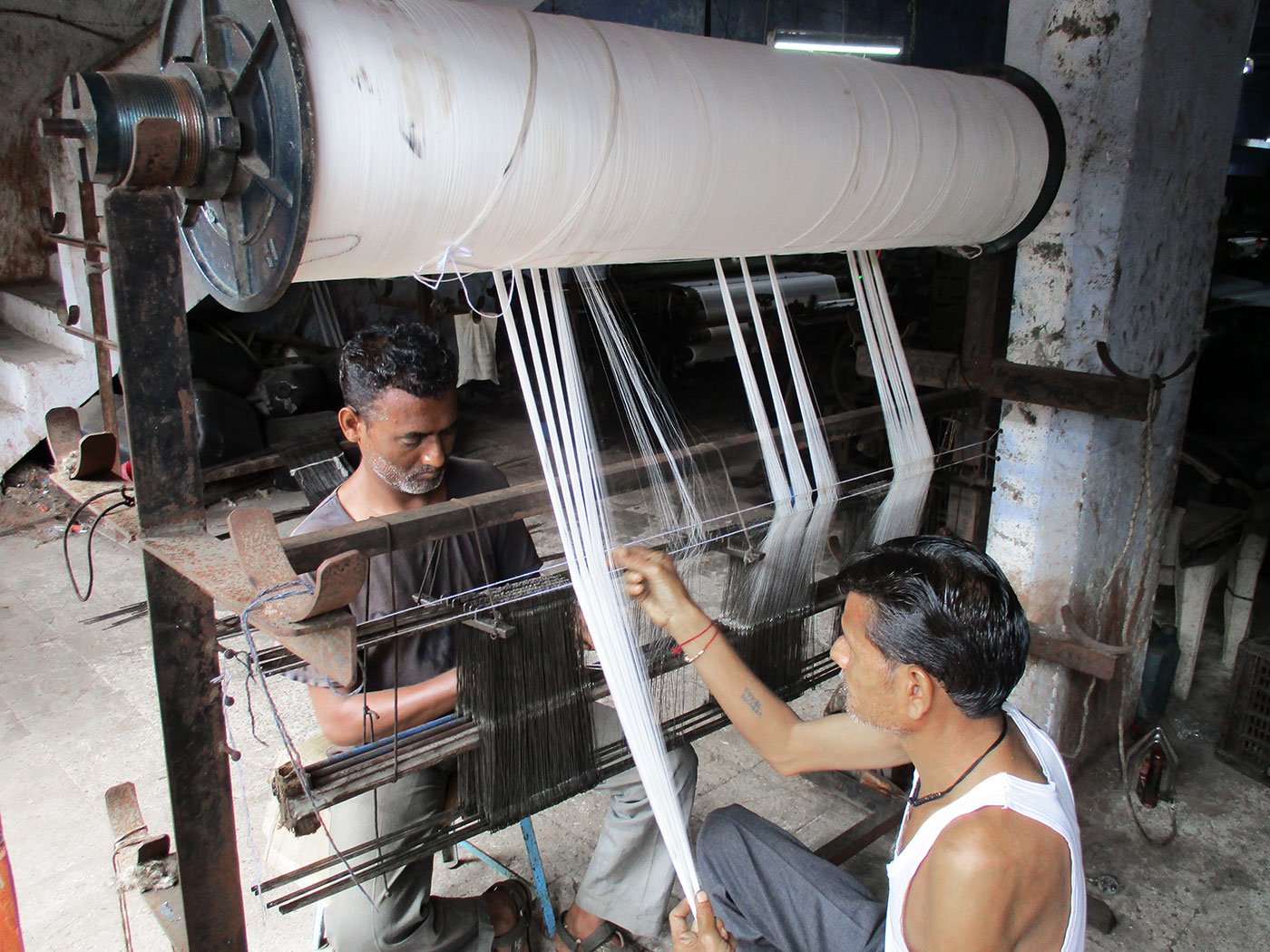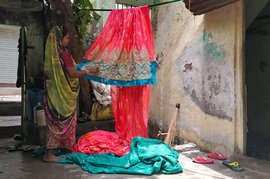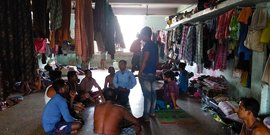“In the past one year, I have conducted 27 funerals,” says Pramod Bisoyi, 45, a loom master from Ganjam district in Odisha, who works in Surat. “The workers’ families are often too poor [to travel to Gujarat] to attend the funerals.”
Bikash Gouda’s father and brothers were right next to him though when he died. It had barely been 24 hours since 16-year-old Bikash entered the gruelling world of loom work. The teenager had travelled more than 1,600 kilometres from his home in Landajuali village in Ganjam to work in a powerloom factory on Ved Road in Surat. On April 25 this year, just as he pushed the starter on a machine, a high voltage current passed through his body – killing him instantly. His father and two older brothers were working on adjacent looms.
“Everyone knew the machine was faulty. We had experienced minor shocks previously… but we never expected it would kill my son,” says his father Charan Gouda, who has been working in Surat for nearly three decades. “Our condition back home is very difficult. I thought by bringing even my youngest son here we would be able to save some money for the family.”


A young worker on an embroidery machine in a unit in Fulwadi. Right: Loom master Pramod Bisoyi with other workers in Anjani
Two weeks later, on May 10, in a loom unit in the Gujarat Industrial Development Corporation area in Sachin (in the Surat metropolitan region), Rajesh Agarwal was sucked into a machine. The young migrant from Maharashtra was killed on the spot. “The machine was old. It would not stop unless there was a power failure,” said a co-worker in the crowd that gathered outside after the incident. “He may have inserted his hand to fix the thread… and got pulled in.” Since then, the unit has been locked down.
Electrocution and burns, asphyxiation and falls, loss of fingers and crushed limbs, and death – the workers and masters say that a large number of such accidents in the powerloom units of Surat go unreported or uncompensated “nearly every day.”
Hanging by a polyester thread
In a unit spanning around 1,000 square feet in the Mina Nagar area in north Surat, more than 100 loom machines operate right next to each other. There is no alley way, and workers – 80 to 100 per shift – don’t have the space to even stretch their arms in between their 12-hour shifts from 7 a.m. to 7 p.m. or 7 p.m. to 7 a.m. Multiple closed circuit television cameras monitor their every act. The closest public toilet is a few blocks away. It is 41 degrees Celsius outside in May, but there is no provision for drinking water and the men carry it in from nearby chai stalls. There are no windows.
The workers continuously move their feet and legs at great speed to ensure that the thread gets woven quickly. “Every minute counts in here… actually every second,” says loom master Bisoyi. The workers get paid on a piece-rate basis – Rs 1.10 to Rs 1.50 for every metre. So, Bisoyi adds, they “cannot afford to waste any time or relax.” Their only days off in a year are because of “electric power failures.” After clocking in nearly 360 hours a month, a worker earns Rs. 7,000 to Rs. 12,000, of which at least Rs. 3,500 is spent on rent and food.
Over these 360 hours a month, the loom workers of Surat produce around 90 per cent of the polyester used in India – churning out nearly 30 million metres of raw fabric and 25 million metres of processed fabric every day, says an August 2017 report titled Labour Conditions in Surat Textile Industry by the People’s Training and Research Centre (PTRC), a Vadodara-based non-governmental organisation.

In many of these windowless factories in Surat, hundreds of workers clock in 12 hour shifts, working amid the literally deafening din of the looms
The looms they labour on are spread across Surat and its outskirts – in small factories in Pandesara, Udhna, Limbayat, Bhestan, Sachin, Katargam, Ved Road and Anjani. The city has around 1.5 million loom machines, estimates Aajeevika Bureau, an organisation working with migrant workers in Gujarat, Rajasthan and Maharashtra.
These looms are the site of a high number of minor, major and fatal injuries among workers – very many of them migrants from Ganjam. The PTRC study says 84 fatal events that killed a total of 114 workers were reported between 2012 and 2015 in registered textile processing units in Surat. During the same period, 375 workers were seriously injured. This data was obtained after filing Right to Information applications at the Directorate of Industrial Safety and Health, Gujarat. The city also houses many unregistered powerloom workshops, and the number of deaths and accidents could be underestimated.
No comprehensive official data is available on any of this.
Most of the looms are registered under the Shops and Establishment Act, points out Jagdish Patel, director, PTRC, and not under the Factories Act which at least mandates that workers or their families must be paid compensation if there is an accident or death.
The workers don’t get any contracts. Recruitments are finalised verbally. “Every time they go back home for a break during a festival or the marriage season, they are not sure that they will have the job when they return. They are so easily replaceable," says Prahlad Swain, a member of the Pravasi Shramik Suraksha Manch (PSSM), a loom and textile workers’ collective in Surat and adjoining areas, established in January 2016. "There is no guarantee that our jobs will remain when we return," adds Simanchala Sahu, 36, a migrant worker from Badakhandi village in Ganjam. "The workers have to let go of their pay for the days they are away."

A powerloom factory in Fulwadi: there is barely any space to move when the workers are here, and every minute of weaving counts, so breaks are rare
With no bargaining power, in cases involving accidents and deaths of migrant loom workers, very little progress is made, says J.K. Gamit, assistant sanitary inspector at the Surat Municipal Corporation. “The workers’ families are far away in their villages and their friends in the city are also workers employed in the looms. They are too busy to keep visiting the police station or following up," he says. “There is no official documentation of the number of injuries and deaths. The case gets closed almost immediately.”
Usually, if there is a death at the loom, a police case is registered. But this is a legal and medical formality, and arrests are very rare. To claim compensation, the family has to approach the labour department. If it’s for an injury, the worker’s job is at stake since this can antagonise the employer. Most resign to an out-of-court settlement.
So four days after young Bikash Gouda died, on April 29 his employer paid the family Rs. 2.10 lakhs as compensation, clearly stating that no further claim could be made. Usually, employers pay at most Rs. 50,000 only so that they can close the case – and the process can take months. In this instance, because the PSSM and Aajeevika Bureau intervened, the amount was increased and disbursed speedily.
Three jobs were at stake. The family agreed.
From Ganjam to Gujarat
Surat is home to at least 800,000 workers from Ganjam, estimates Rajesh Kumar Padhi, a member of the Surat Odia Welfare Association. Around 70 per cent of them work in the city’s powerloom sector. “The migration corridor between Odisha and Surat opened up around 40 years ago,” he says. “Although Ganjam is considered a developed district in Odisha,” the PTRC report states, “shrinking natural resources, decreasing agricultural land and regular floods and drought have impelled the migration.”
The Ganjam migrants though are not employed in Surat's other big industry – diamonds – points our Jagdish Patel. “Those jobs are usually reserved for local Gujarati workers because the employers recruit only people ‘of their confidence’. The Ganjam workers have remained at the lower-end of the loom units, undertaking the monotonous task of running the machines the same way every single day for years."
Still, this the workers say is better than the situation back home. Simanchala Sahu, who is also a member of the PSSM, says “The condition in Ganjam is very challenging. A few workers might have migrated in the beginning, and then they have been coming in large groups, some with family members and neighbours.”


Simanchala Sahu (left) from Odisha’s Ganjam district has been working in a powerloom unit on Ved Road for two decades. Shambunath Sahu (right) from Polasara town in Ganjam runs a mess for the loom workers on Ved Road
Most of the migrant workers in the powerloom sector are men. Women from Ganjam are few in Surat, and they usually work in embroidery or cloth-cutting units, or from home on a piece-rate basis. A few of the women come to Surat after their husbands are well-settled in the city. Mostly though, the male workers live away from their families, visiting home once a year or once every two years for a few weeks. ( More on this in the next story in this series .)
A large number of the migrants are Dalits from the Kewat caste, who work as fishermen or boatmen in their villages. Some workers such as Sahu belong to OBC communities. Most of them don’t own any land. “The main source of income is agriculture, which is highly dependent on the weather and flood situation. There are no other opportunities,” says Swain. “This has driven many all the way to Surat. At least they earn money to send back home even if it comes at the cost of their overall health.”
It is this helplessness that has normalised the high levels of exploitation in the factories. “For every worker injured or killed, there are many more young and desperate workers coming to the city every day,” said Rushikesh Rout, 38, a powerloom worker from Berhampur town in Ganjam, who lost three fingers in an electricity pole accident in February 2017. “Even the owners know well that no injury or accident could be as bad the circumstances at home.” Rout now works as a security guard in Surat with little hope of being compensated for his lost fingers because the accident happened at his one-room home in the Pandesara industrial area of Surat.
Daily struggles, permanent effects
In addition to the gruelling schedule and low wages, a growing number of powerloom workers are becoming deaf because of the constant loud noise in the workshops. “The average sound level inside the loom unit is more than 110 decibels,” says Sanjay Patel, centre coordinator at Aajeevika Bureau. In January this year, the organisation conducted audiometry tests on 65 loom workers employed in different units. The results – certified by the Christian Medical College and Hospital in Vellore – show that 95 per cent had varying levels of deafness. “Even as loss of hearing is becoming increasingly common among the workers, the fact that it doesn’t come in the way of their everyday physical labour means it is not taken seriously by the owners. They are not given any protective gear… and the workers cannot question,” says Patel.

Rushikesh Rout, 38, a former powerloom unit worker, lost three fingers in an accident last year
A ‘hierarchy’ of machinery within the unit adds to the workers' vulnerability. A powerloom owner at the Anjani Industrial Estate, who employs nearly 80 workers at his looms, tells me that the “Ganjam lot” is not allowed to work on the higher-grade machines imported from China, Germany and Korea. “These workers are allowed to use only the cheaper locally-produced machines. These are hard [to work on] and make more noise.” These khat khat machines, so called because of the noise they make, do the same job as the expensive ones, but produce inferior quality fabric sold in the local markets. The higher-grade machines produce material that is exported or sent to the bigger cities.
"The owners usually do not want to spend on safety measures such as sensors on machines. It is expensive, and the industry has not been doing well for the past four years," says Nitin Bhayani, founder member of the Loom Employers' Association in the Anjani Industrial Area's B-4 sector..
Bhayani though believes that in most instances the workers are themselves responsible for the accidents and injuries. "They get drunk and do not concentrate on the work,” he says. “The employers are not in the units to monitor the workers during the nights. This is when most accidents are reported."
Those who survive the loss of limb and other injuries continue to work the same machines over and over – some for as long as three decades – with almost no chance of learning new skills or getting promotions. “It is not easy to rise higher in this industry. Even 65-year-old workers continue to work on the same machines,” says Shambunath Sahu, 40, who runs a workers’ mess in Fulwadi, and has migrated here from Polasara town in Ganjam. “And the workers age quickly…”


